Welcome to HEOM-QUICK Website
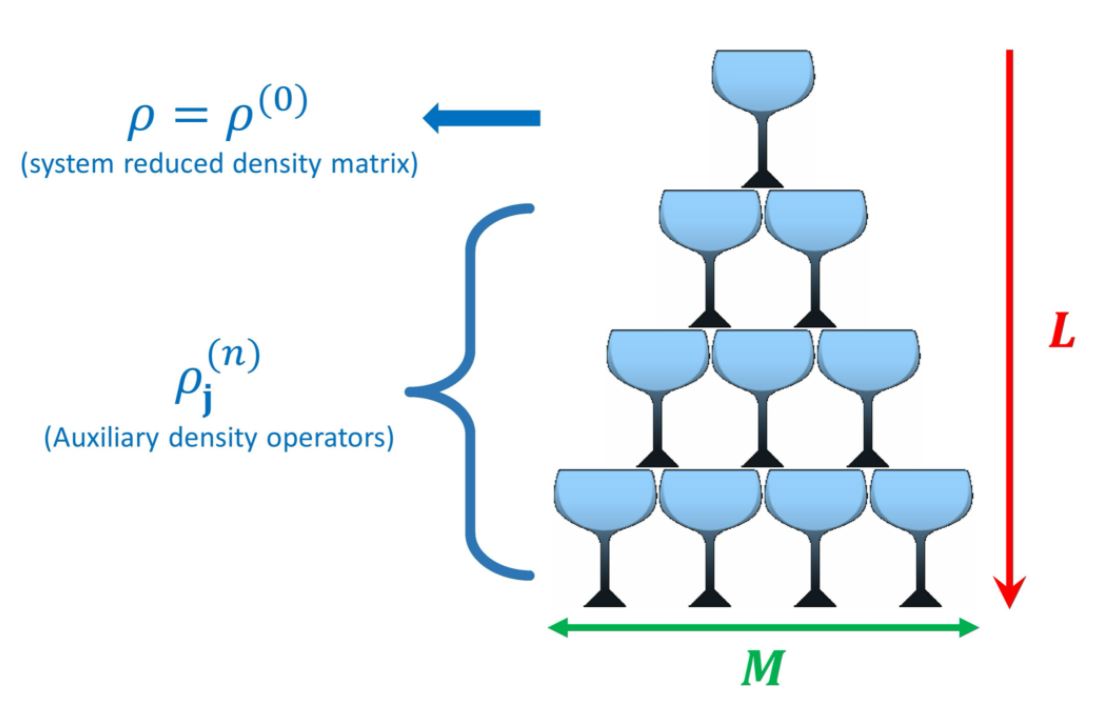
The HEOM-QUICK program implements the formally exact HEOM formalism for fermionic open systems. Its simulation results capture the combined effects of system-environment dissipation, many-body interactions, and non-Markovian memory in a nonperturbative manner.
The Hierarchical Equations of Motion for QUantum Impurity with a Correlated Kernel (HEOM-QUICK) is a program which allows for an accurate and universal characterization of strongly correlated quantum impurity systems. The HEOM-QUICK program has been employed to explore a wide range of static and dynamic properties of various types of quantum impurity systems, including charge or spin qubits, quantum dots, molecular junctions, and so on. It has also been utilized in conjunction with first-principles methods such as density-functional theory methods to study the correlated electronic structure of adsorbed magnetic molecules.
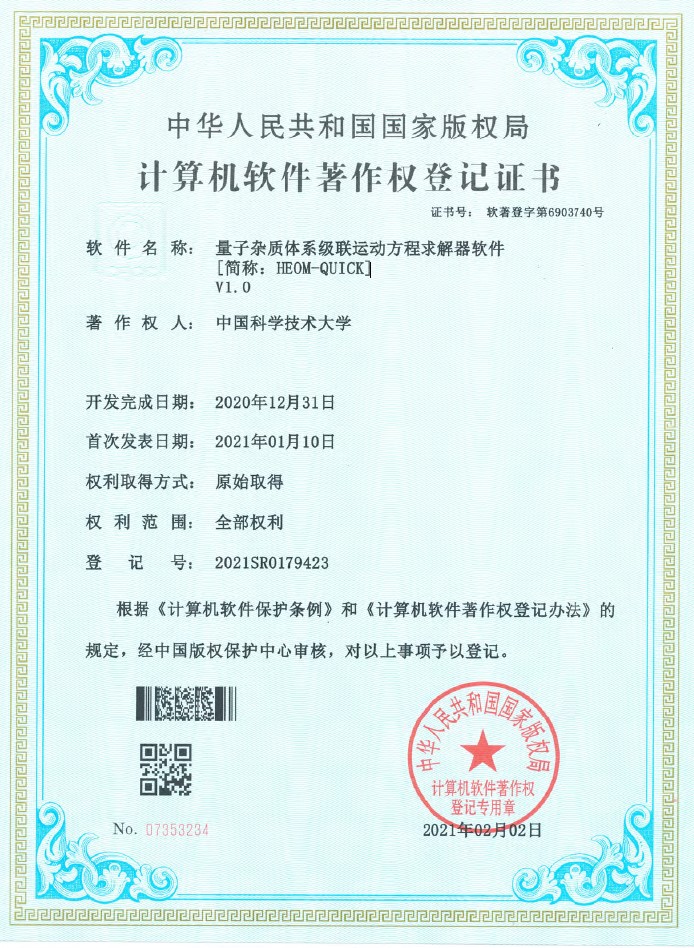
The advantages in its accuracy, efficiency, and universality have made the HEOM-QUICK program a reliable and versatile tool for theoretical investigations on strong electron correlation effects in complex materials.
——HEOM-QUICK: a program for accurate, efficient, and universal characterization of strongly correlated quantum impurity systems
LvZhou Ye, Xiaoli Wang, Dong Hou, Rui-Xue Xu, Xiao Zheng and YiJing Yan
WIREs Computational Molecular Science,(2016). https://doi.org/10.1002/wcms.1269
Applications
Molecular molds for regularizing Kondo states at atom/metal interfaces
Xiangyang
Li, Liang Zhu, Bin Li, Jingcheng Li, Pengfei Gao, Longqing Yang, Aidi Zhao, Yi Luo, Jianguo Hou,
Xiao Zheng, Bing Wang and Jinlong Yang
Nature Communications 11, 2566 (2020)
Adsorption of magnetic transition metal atoms on a metal surface leads to the formation of
Kondo states at the atom/metal interfaces. However, the significant influence of surrounding
environment presents challenges for potential applications. In this work, we realize a novel
strategy to regularize the Kondo states by moving a CoPc molecular mold on an Au(111) surface to
capture the dispersed Co adatoms. The symmetric and ordered structures of the atom-mold complexes,
as well as the strong dπ–π bonding between the Co adatoms and conjugated isoindole units, result in
highly robust and uniform Kondo states at the Co/Au(111) interfaces. Even more remarkably, the CoPc
further enables a fine tuning of Kondo states through the molecular-mold-mediated superexchange
interactions between Co adatoms separated by more than 12 Å. Being highly precise, efficient and
reproducible, the proposed molecular mold strategy may open a new horizon for the construction and
control of nano-sized quantum devices.
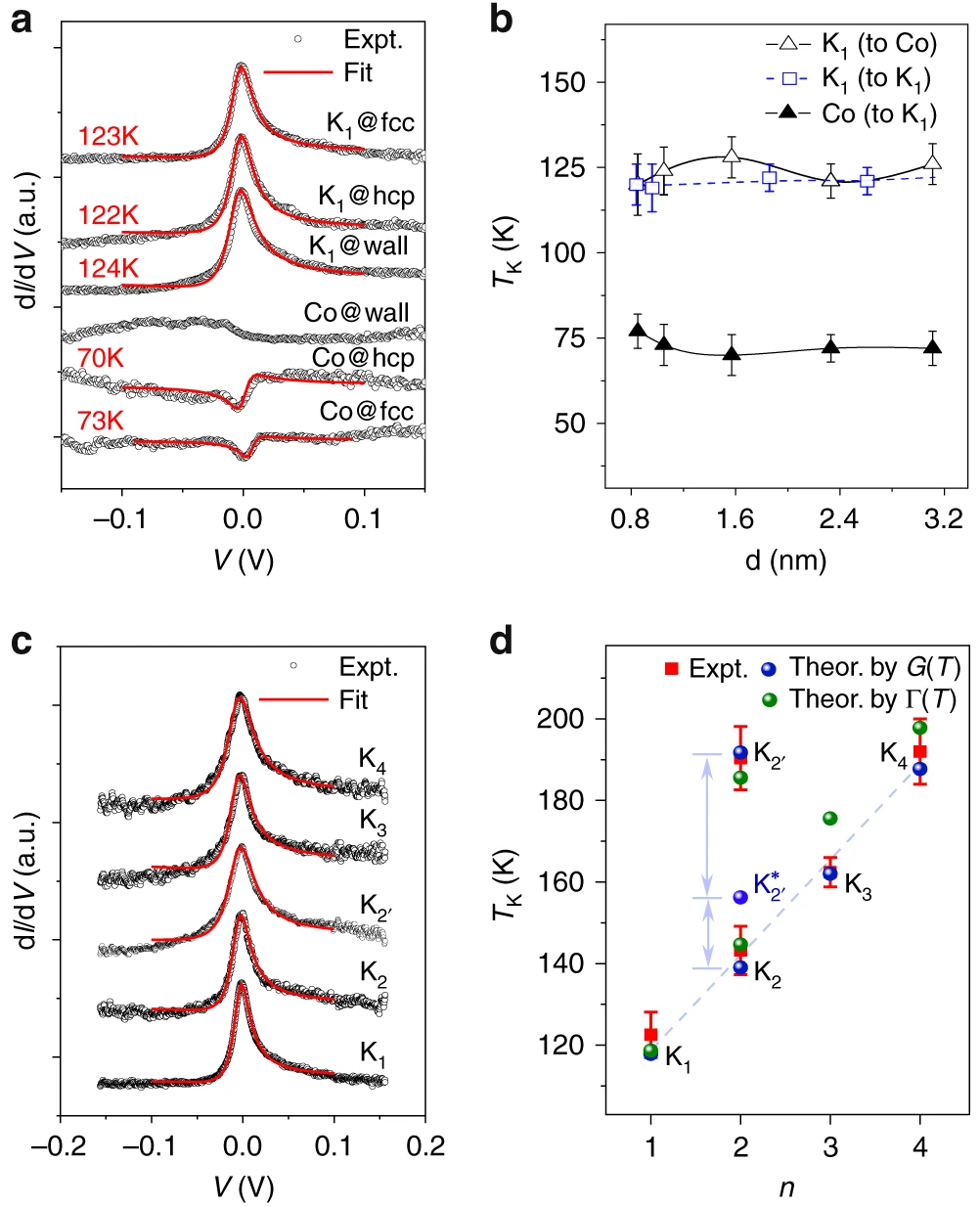
Hierarchical equations of motion method based on Fano spectrum decomposition for low
temperature environments
Hou-Dao Zhang, Lei Cui, Hong Gong, Rui-Xue Xu, Xiao Zheng
and YiJing Yan
Journal of Chemical Physical 152, 064107 (2020)
The
hierarchical equations of motion (HEOM) method has become one of the most popular methods for the
studies of the open quantum system. However, its applicability to systems at ultra-low temperatures
is largely restrained by the enormous computational cost, which is caused by the numerous
exponential functions required to accurately characterize the non-Markovian memory of the reservoir
environment. To overcome this problem, a Fano spectrum decomposition (FSD) scheme has been proposed
recently [Cui et al., J. Chem. Phys. 151, 024110 (2019)], which expands
the reservoir correlation functions using polynomial-exponential functions and hence greatly reduces
the size of the memory basis set. In this work, we explicitly establish the FSD-based HEOM
formalisms for both bosonic and fermionic environments. The accuracy and efficiency of the FSD-based
HEOM are exemplified by the calculated low-temperature dissipative dynamics of a spin-boson model
and the dynamic and static properties of a single-orbital Anderson impurity model in the Kondo
regime. The encouraging numerical results highlight the practicality and usefulness of the FSD-based
HEOM method for general open systems at ultra-low temperatures.
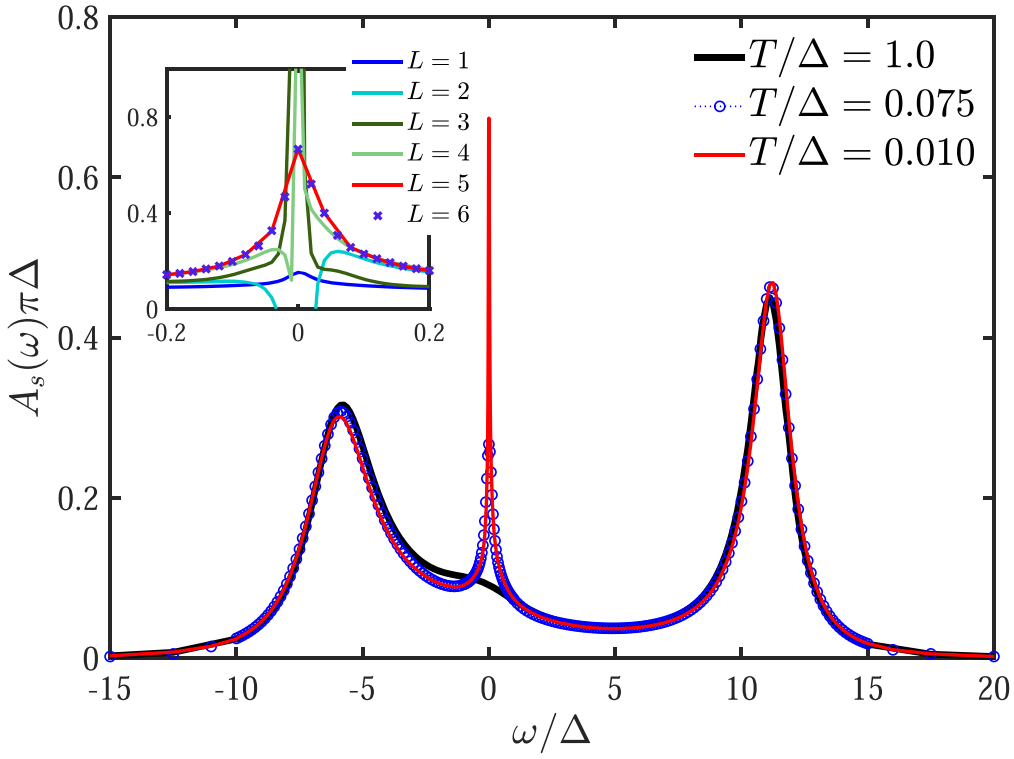
Highly efficient and accurate sum-over-poles expansion of Fermi and Bose functions at near
zero temperatures: Fano spectrum decomposition scheme
Lei Cui, Hou-Dao Zhang, Xiao
Zheng, Rui-Xue Xu and YiJing Yan
Journal of Chemical Physical 151, 024110
(2019)
The Fano spectrum decomposition (FSD) scheme is proposed as an efficient and accurate
sum-over-poles expansion of Fermi and Bose functions at cryogenic temperatures. The new method
practically overcomes the discontinuity of Fermi and Bose functions near zero temperature, which
causes slow convergence in conventional schemes such as the state-of-the-art Padé spectrum
decomposition (PSD). The FSD scheme fragments Fermi or Bose function into a high-temperature
reference and a low-temperature correction. While the former is efficiently decomposed via the
standard PSD, the latter can be accurately described by several modified Fano functions. The
resulting FSD scheme is found to converge overwhelmingly faster than the standard PSD method.
Remarkably, the low-temperature correction supports further a recursive and scalable extension to
access the near-zero temperature regime. Thus, the proposed FSD scheme, which obeys rather simple
recursive relations, has a great value in efficient numerical evaluations of Fermi or Bose
function-involved integrals for various lowtemperature condensed physics formulations and problems.
For numerical demonstrations, we exemplify FSD for the efficient unraveling of fermionic reservoir
correlation functions and the exact hierarchical equations of motion simulations of spin-boson
dynamics, both at extremely low temperatures.
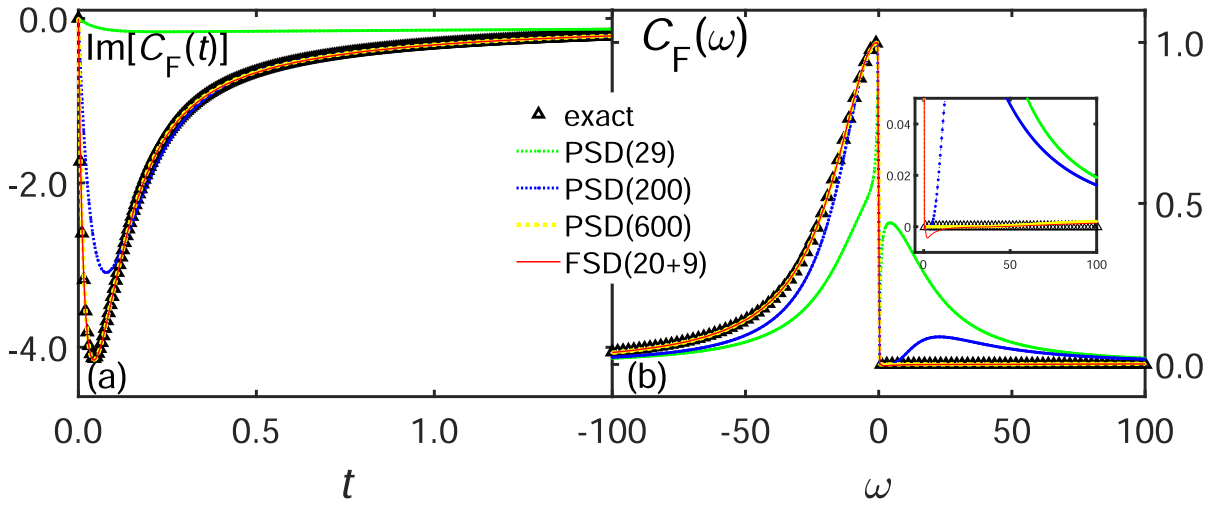
Quantum Entanglement of Parallel-Coupled Double Quantum Dots: a Theoretical
Study Using the Hierarchical Equations of Motion Approach
Hong Gong, Arif Ullah,
LvZhou Ye, Xiao Zheng and YiJing Yan
Chinese Journal of Chemical Physics 31,
510 (2018)
Quantum dots comprise a type of quantum impurity system. The entanglement and
coherence of quantum states are significantly influenced by the strong electron-electron
interactions among impurities and their dissipative coupling with the surrounding environment.
Competition between many-body effects and transfer couplings plays an important role in determining
the entanglement among localized impurity spins. In this work, we employ the
hierarchical-equations-of-motion approach to explore the entanglement of a strongly correlated
double quantum dots system. The relation between the total system entropy and those of subsystems is
also investigated.
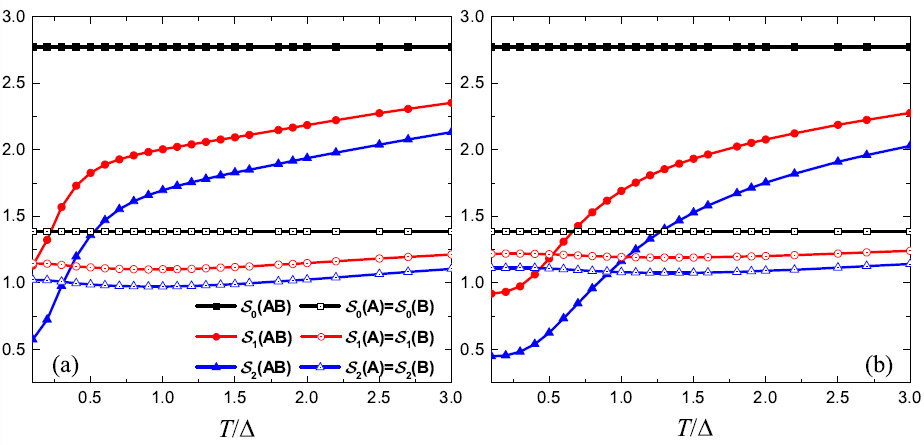
Precise Control of Local Spin States in an Adsorbed Magnetic Molecule with an
STM Tip: Theoretical Insights from First-Principles-Based Simulation
Xiaoli Wang,
Longqing Yang, LvZhou Ye, Xiao Zheng and YiJing Yan
The Journal of Physical Chemistry Letters
9, 2418-2425 (2018)
The precise tuning of local spin states in adsorbed
organometallic molecules by a mechanically controlled scanning tunneling microscope (STM) tip has
become a focus of recent experiments. However, the underlying mechanisms remain somewhat unclear. We
investigate theoretically the STM tip control of local spin states in a single iron(II) porphyrin
molecule adsorbed on the Pb(111) substrate. A combined density functional theory and hierarchical
equations of motion approach is employed to simulate the tip tuning process in conjunction with the
complete active space self-consistent field method for accurate computation of magnetic anisotropy.
Our first-principles-based simulation accurately reproduces the tuning of magnetic anisotropy
realized in experiment. Moreover, we elucidate the evolution of geometric and electronic structures
of the composite junction and disclose the delicate competition between the Kondo resonance and
local spin excitation. The understanding and insight provided by the first-principles-based
simulation may help to realize more fascinating quantum state manipulations.
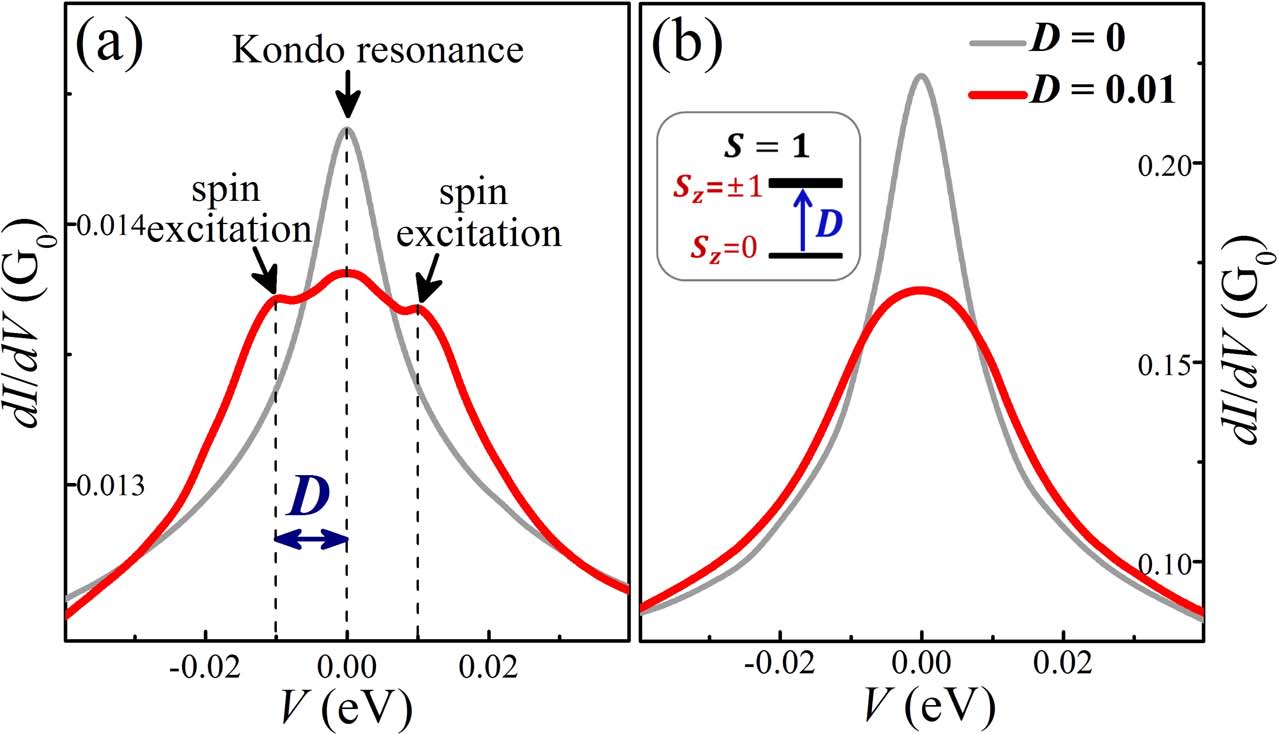
Kondo screening and spin excitation in few-layer CoPc molecular assembly
stacking on Pb(111) surface: A DFT+HEOM study
Yu Wang, Xiao Zheng, and Jinlong
Yang
The Journal of Chemical Physics 145, 154301 (2016)
Transition metal
phthalocyanine molecules adsorbed on a metal substrate exhibit rich spin-related phenomena such as
magnetic anisotropy, spin excitation, and Kondo effect. In this work, we investigate theoretically
few-layer cobalt phthalocyanine (CoPc) molecular assembly stacking on Pb(111) surface with the use
of a combined density functional theory (DFT) and hierarchical equations of motion (HEOM) approach.
Calculation results indicate that the local spin properties of CoPc/Pb(111) composites depend
critically on the number of adsorption layers. The first layer of CoPc on the Pb(111) surface serves
as a spin-insulating buffer, while the CoPc molecules in the second layer exhibit spin–1/2 Kondo
effect with a Kondo temperature of about 22 K. In a triple-layer CoPc assembly stacking on Pb(111),
the antiferromagnetic coupling between the second and third layers leads to local spin-flip
excitations under finite bias voltages, which gives rise to characteristic signatures in the
differential conductance spectra. The DFT+HEOM approach thus provides a practical means for
investigating the local electronic and spin properties of two-dimensional molecular assemblies
adsorbed on the metal surface. The insights obtained from the first-principles based simulations
could be useful for experimental manipulation or design of magnetic composite systems.
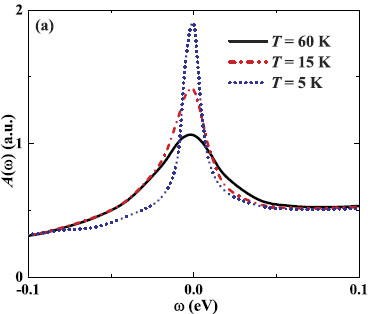
Environment-modulated Kondo phenomena in FePc/Au(111) adsorption
systems
Yu Wang, Xiao Zheng, and Jinlong Yang
Physical Review B
93, 125114 (2016)
Recent scanning tunneling microscopy experiments on electron
transport through iron(II) phthalocyanine (FePc) molecules adsorbed on the Au(111) surface have
revealed that the measured Kondo conductance signature depends strongly on the specific adsorption
site. To understand the physical origin of experimental observations, particularly the variation of
Kondo features with the molecular adsorption site, we employ a combined density functional theory
(DFT) and hierarchical equations of motion (HEOM) approach to investigate the electronic structure
and Kondo correlation in FePc/Au(111) composite systems. The calculation results indicate that, for
the on-top adsorption configuration, the two degenerate spin-unpaired dπ orbitals on the Fe center
are coupled indirectly through substrate band states, leading to the Fano-like antiresonance line
shape in the dI/dV spectra, while for the bridge adsorption configuration, the environment-induced
couplings are largely suppressed because of the two different spin-unpaired d orbitals. Therefore,
our work suggests that the environment-induced coupling as an essential physical factor could
greatly influence the Fano-Kondo features in magnetic molecule/metal composites, and the crucial
role of local orbital degeneracy and symmetry is discovered. These findings provide important
insights into the electron correlation effects in complex solid-state systems. The usefulness and
practicality of the combined DFT+HEOM method is also highlighted.
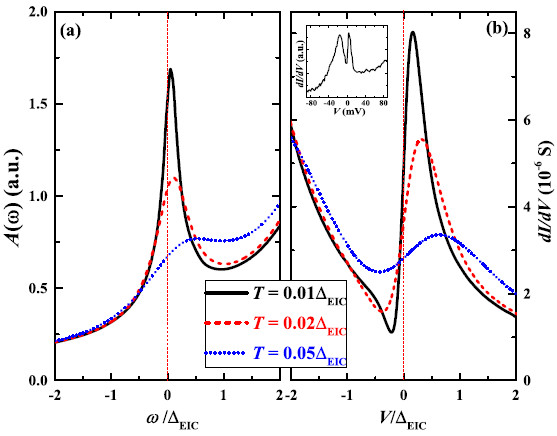
Anisotropy induced Kondo splitting in a mechanically stretched molecular
junction: A first-principles based study
Xiaoli Wang, Dong Hou, Xiao Zheng, and
YiJing Yan
The Journal of Chemical Physics 144, 034101 (2016)
The magnetic
anisotropy and Kondo phenomena in a mechanically stretched magnetic molecular junction are
investigated by combining the density functional theory (DFT) and hierarchical equations of motion
(HEOM) approach. The system is comprised of a magnetic complex Co(tpy–SH)2 sandwiched between
adjacent gold electrodes, which is mechanically stretched in experiments done by Parks et al.
[Science 328, 1370 (2010)]. The electronic structure and mechanical property of the stretched system
are investigated via the DFT calculations. The HEOM approach is then employed to characterize the
Kondo resonance features, based on the Anderson impurity model parameterized from the DFT results.
It is confirmed that the ground state prefers the S = 1 local spin state. The structural properties,
the magnetic anisotropy, and corresponding Kondo peak splitting in the axial stretching process are
systematically evaluated. The results reveal that the strong electron correlations and the local
magnetic properties of the molecule magnet are very sensitive to structural distortion. This work
demonstrates that the combined DFT+HEOM approach could be useful in understanding and designing
mechanically controlled molecular junctions.

Thermodynamic meaning of local temperature of nonequilibrium open quantum
systems
LvZhou Ye, Xiao Zheng, YiJing Yan, and Massimiliano Di Ventra
Physical
Review B 94, 245105 (2016)
Measuring the local temperature of nanoscale
systems out of equilibrium has emerged as a new tool to study local heating effects and other local
thermal properties of systems driven by external fields. Although various experimental protocols and
theoretical definitions have been proposed to determine the local temperature, the thermodynamic
meaning of the measured or defined quantities remains unclear. By performing analytical and
numerical analysis of bias-driven quantum dot systems both in the noninteracting and
strongly-correlated regimes, we elucidate the underlying physical meaning of local temperature as
determined by two definitions: the zero-current condition that is widely used but not measurable and
the minimal-perturbation condition that is experimentally realizable. We show that, unlike the
zero-current condition, the local temperature determined by the minimal-perturbation protocol
establishes a quantitative correspondence between the nonequilibrium system of interest and a
reference equilibrium system, provided the probed system observable and the related electronic
excitations are fully local. The quantitative correspondence thus allows the well-established
thermodynamic concept to be extended to nonequilibrium situations.
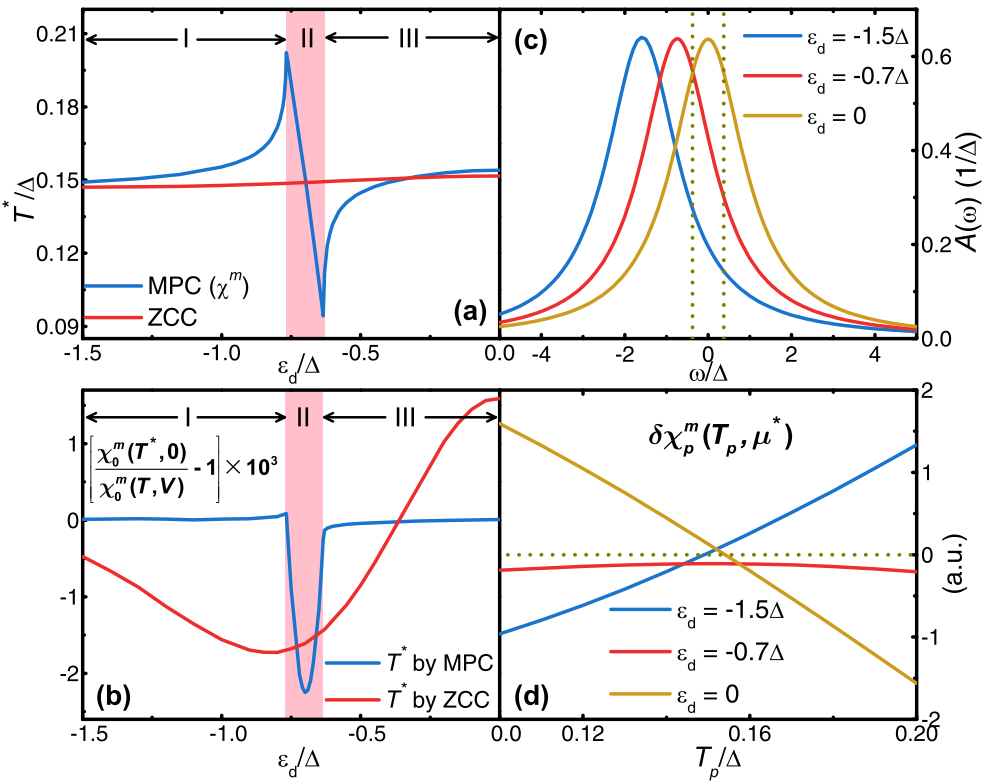
Local temperatures of strongly-correlated quantum dots out of equilibrium
LvZhou
Ye, Dong Hou, Xiao Zheng, YiJing Yan, and Massimiliano Di Ventra
Physical Review B
91, 205106 (2015)
Probes that measure the local thermal properties of systems
out of equilibrium are emerging as new tools in the study of nanoscale systems. One can then measure
the temperature of a probe that is weakly coupled to a bias-driven system. By tuning the probe
temperature so that the expectation value of some observable of the system is minimally perturbed,
one obtains a parameter that measures its degree of local statistical excitation, and hence its
local heating. However, one anticipates that different observables may lead to different
temperatures and thus different local heating expectations. We propose an experimentally realizable
protocol to measure such local temperatures and apply it to bias-driven quantum dots. By means of a
highly accurate open quantum system approach, we show theoretically that the measured temperature is
quite insensitive both to the choice of observable and to the probe-system coupling. In particular,
even with observables that are distinct both physically and in their degree of locality, such as the
local magnetic susceptibility of the quantum dot and the global spin-polarized
current measured at the leads, the resulting local temperatures are quantitatively similar for
quantum dots ranging from noninteracting to Kondo-correlated regimes, and are close to those
obtained with the traditional “local equilibrium” definition.

Thermopower of few-electron quantum dots with Kondo correlations
LvZhou Ye, Dong Hou, Rulin Wang, Dewen Cao, Xiao Zheng, and YiJing Yan
Physical Review B
90, 165116 (2014)
The thermopower of few-electron quantum dots is crucially
influenced by on-dot electron-electron interactions, particularly in the presence of Kondo
correlations. In this paper, we present a comprehensive picture which elucidates the underlying
relations between the thermopower and the spectral density function of two-level quantum dots. The
effects of various electronic states, including the Kondo states originating from both spin and
orbital degrees of freedom, are clearly unraveled. Such a physical picture is affirmed by accurate
numerical data obtained with a hierarchical equations of motion approach. Our findings and
understandings provide an effective and viable way to control the thermoelectric properties of
strongly correlated quantum dot systems.
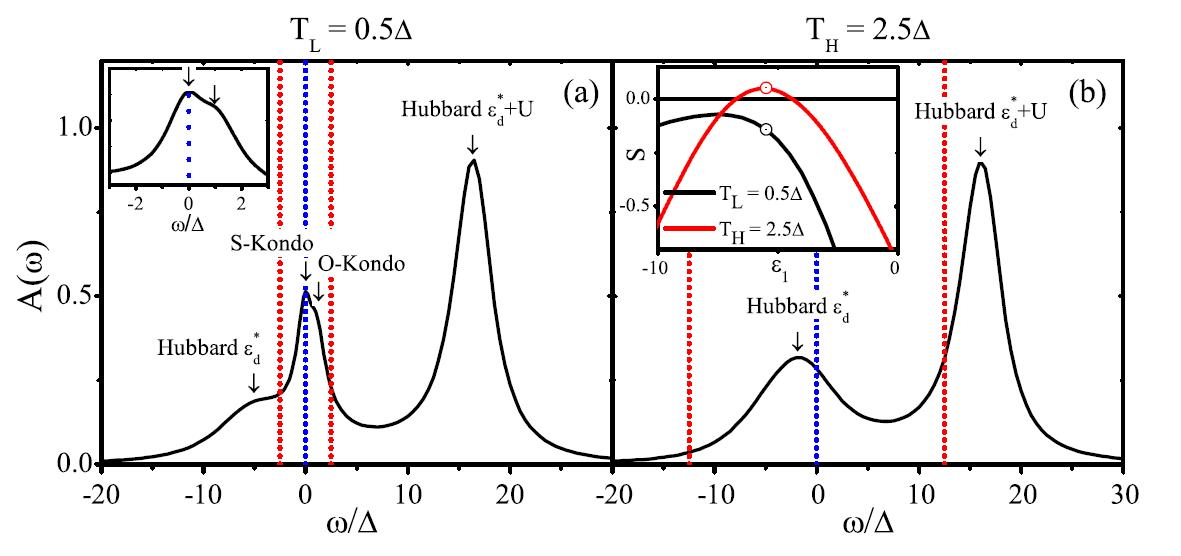
Improving the efficiency of hierarchical equations of motion approach and
application to coherent dynamics in Aharonov–Bohm interferometers
Dong Hou, Shikuan
Wang, Rulin Wang, LvZhou Ye, RuiXue Xu, Xiao Zheng, and YiJing Yan
The Journal
of Chemical Physics 142, 104112 (2015)
Several recent
advancements for the hierarchical equations of motion (HEOM) approach are reported. First, we
propose an a priori estimate for the optimal number of basis functions for the reservoir memory
decomposition. Second, we make use of the sparsity of auxiliary density operators (ADOs) and propose
two ansatzs to screen out all the intrinsic zero ADO elements. Third, we propose a new truncation
scheme by utilizing the time derivatives of higher-tier ADOs. These novel techniques greatly reduce
the memory cost of the HEOM approach, and thus enhance its efficiency and applicability. The
improved HEOM approach is applied to simulate the coherent dynamics of Aharonov–Bohm double quantum
dot interferometers. Quantitatively accurate dynamics is obtained for both noninteracting and
interacting quantum dots. The crucial role of the quantum phase for the magnitude of quantum
coherence and quantum entanglement is revealed.
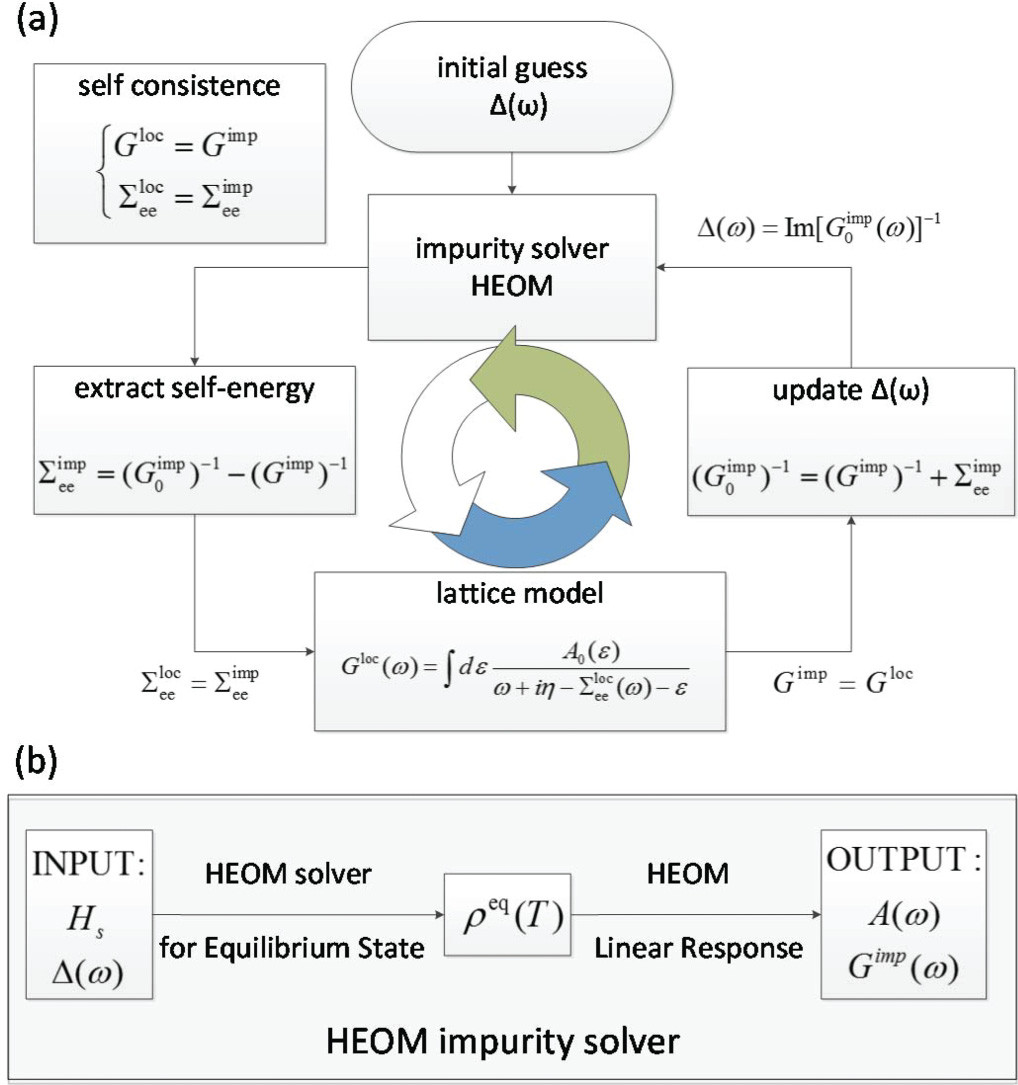
Hierarchical equations of motion for an impurity solver in dynamical mean-field
theory
Dong Hou, Rulin Wang, Xiao Zheng, NingHua Tong,JianHua Wei and YiJing
Yan
Physical Review B 90, 045141 (2014)
A nonperturbative quantum impurity
solver is proposed based on a formally exact hierarchical equations of motion (HEOM) formalism for
open quantum systems. It leads to quantitatively accurate evaluation of physical properties of
strongly correlated electronic systems, in the framework of dynamical mean-field theory (DMFT). The
HEOM method is also numerically convenient to achieve the same level of accuracy as that using the
state-of-the-art numerical renormalization group impurity solver at finite temperatures. The
practicality of the HEOM+DMFT method is demonstrated by its applications to the Hubbard models with
Bethe and hypercubic lattice structures. We investigate the metal-insulator transition phenomena,
and address the effects of temperature on the properties of strongly correlated lattice systems.

Kondo Memory in Driven Strongly Correlated Quantum Dots
Xiao Zheng, YiJing Yan,
and Massimiliano Di Ventra
Physical Review Letters 111, 086601 (2013)
We
investigate the real-time current response of strongly correlated quantum dot systems under
sinusoidal driving voltages. By means of an accurate hierarchical equations of motion approach, we
demonstrate the presence of prominent memory effects induced by the Kondo resonance on the real-time
current response. These memory effects appear as distinctive hysteresis line shapes and
self-crossing features in the dynamic current-voltage characteristics, with concomitant excitation
of odd-number overtones. They emerge as a cooperative effect of quantum coherence—due to inductive
behavior—and electron correlations—due to the Kondo resonance. We also show the suppression of
memory effects and the transition to classical behavior as a function of temperature. All these
phenomena can be observed in experiments and may lead to novel quantum memory applications.

Hierarchical equations of motion approach for accurate characterization of spin excitations
in quantum impurity systems
Daochi Zhang†, Lijun Zuo†, Lyuzhou Ye, Zi-Hao Chen, Yao
Wang, Rui-Xue Xu, Xiao Zheng*, and YiJing Yan
J. Chem. Phys. 158, (1), 014106
(2023). DOI: 10.1063/5.0131739
Recent technological advancement in scanning tunneling
microscopes has enabled the measurement of spin-field and spin–spin interactions in single atomic or
molecular junctions with an unprecedentedly high resolution. Theoretically, although the fermionic
hierarchical equations of motion (HEOM) method has been widely applied to investigate the strongly
correlated Kondo states in these junctions, the existence of low-energy spin excitations presents
new challenges to numerical simulations. These include the quest for a more accurate and efficient
decomposition for the non-Markovian memory of low-temperature environments and a more careful
handling of errors caused by the truncation of the hierarchy. In this work, we propose several new
algorithms, which significantly enhance the performance of the HEOM method, as exemplified by the
calculations on systems involving various types of low-energy spin excitations. Being able to
characterize both the Kondo effect and spin excitation accurately, the HEOM method offers a
sophisticated and versatile theoretical tool, which is valuable for the understanding and even
prediction of the fascinating quantum phenomena explored in cutting-edge experiments.
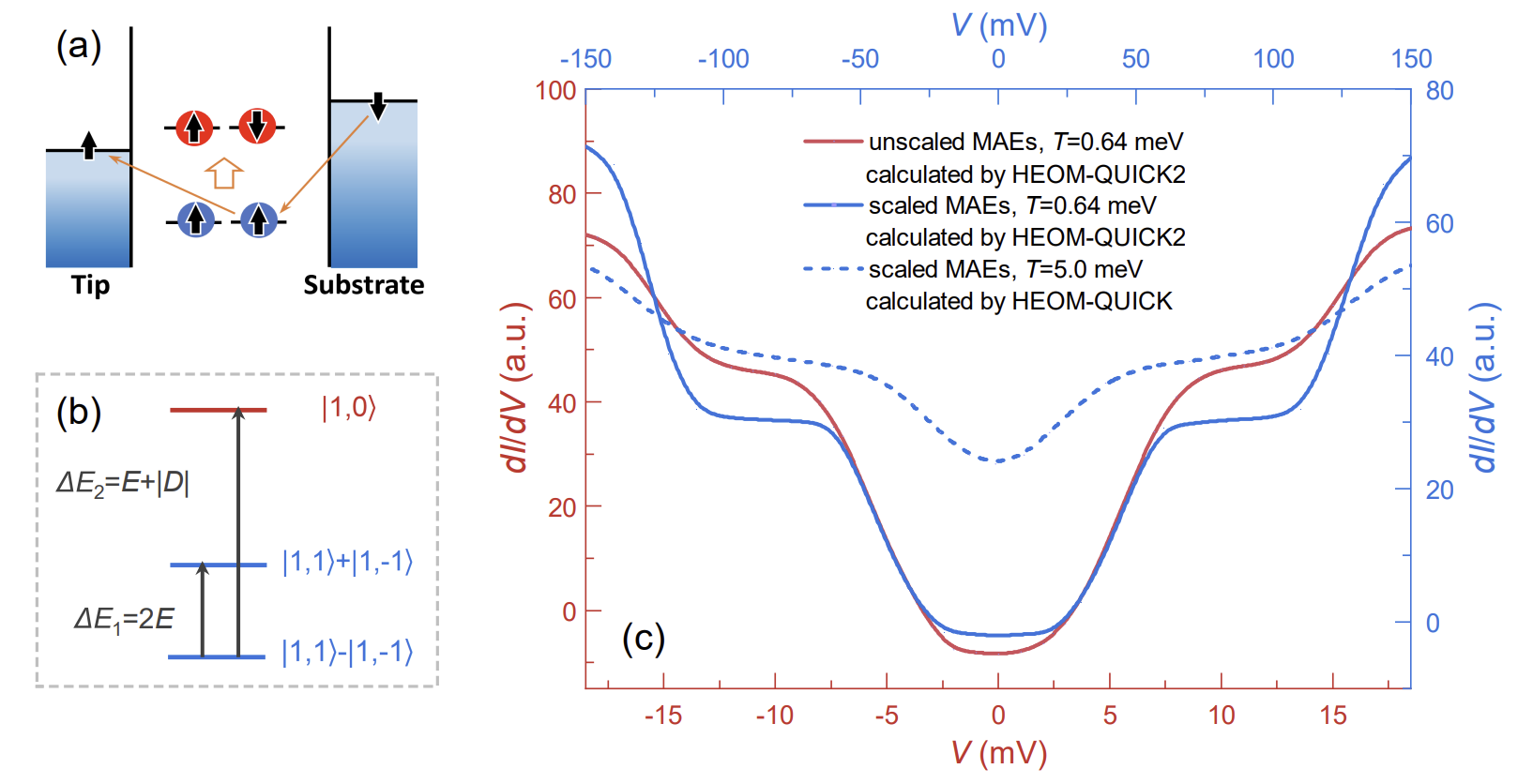
Publication
publication of our group
1. Jinshuang Jin*, Xiao Zheng, and YiJing
Yan*, “Exact dynamics of dissipative electronic systems and quantum transport: Hierarchical
equations of motion approach”, J. Chem. Phys. 128, 234703 (2008). https://doi.org/10.1063/1.2938087
2. Xiao Zheng*, Jinshuang Jin, and YiJing Yan*, “Dynamic electronic response of
a quantum dot driven by time-dependent voltage”, J. Chem. Phys. 129, 184112 (2008). https://doi.org/10.1063/1.3010886
3. Xiao Zheng, Jinshuang Jin, and YiJing Yan*, “Dynamic Coulomb blockade in
single-lead quantum dots”, New J. Phys. 10, 093016 (2008). https://doi.org/10.1088/1367-2630/10/9/093016
4. Xiao Zheng*, JunYan Luo, Jinshuang Jin, and YiJing Yan*, “Complex
non-Markovian effect on time-dependent quantum transport”, J. Chem. Phys. 130, 124508 (2009). https://doi.org/10.1063/1.3095424
5. Xiao Zheng*, Jinshuang Jin, Sven Welack, Meng Luo, and YiJing Yan*,
“Numerical approach to time-dependent quantum transport and dynamical Kondo transition”, J. Chem.
Phys. 130, 164708 (2009). https://doi.org/10.1063/1.3123526
6. Xiao Zheng, GuanHua Chen*, Yan Mo, SiuKong Koo, Heng Tian, ChiYung Yam, and
YiJing Yan*, “Time-dependent density functional theory for quantum transport”, J. Chem. Phys. 133,
114101 (2010). https://doi.org/10.1063/1.3475566
7. Xiao Zheng, Rui-Xue Xu, Jian Xu, Jinshuang Jin, Jie Hu, and YiJing Yan*,
“Hierarchical equations of motion for quantum dissipation and quantum transport”, Prog. Chem. 24,
1129 (2012). link
8. ZhenHua Li, NingHua Tong, Xiao Zheng*, Dong Hou, JianHua Wei*, Jie Hu, and
YiJing Yan*, Hierarchical Liouville-Space Approach for Accurate and Universal Characterization of
Quantum Impurity Systems. Phys. Rev. Lett. 109, 266403 (2012). https://doi.org/10.1103/PhysRevLett.109.266403
9. Shikuan Wang, Xiao Zheng*, Jinshuang Jin, and YiJing Yan*, “Hierarchical
Liouville-space approach to nonequilibrium dynamical properties of quantum impurity systems”, Phys.
Rev. B 88, 035129 (2013). https://doi.org/10.1103/PhysRevB.88.035129
10. Xiao Zheng, YiJing Yan, and Massimiliano Di Ventra, “Kondo memory in driven
strongly correlated quantum dots”, Phys. Rev. Lett. 111, 086601 (2013). https://doi.org/10.1103/PhysRevLett.111.086601
11. Dong Hou, Rulin Wang, Xiao Zheng*, NingHua Tong*, JianHua Wei, and YiJing
Yan*, “Hierarchical equations of motion for an impurity solver in dynamical mean-field theory”,
Phys. Rev. B 90, 045141 (2014). https://doi.org/10.1103/PhysRevB.90.045141
12. Yu Wang, Xiao Zheng*, Bin Li, and Jinlong Yang*, “Understanding the Kondo
resonance in the d-CoPc/Au(111) adsorption system”, J. Chem. Phys. 141, 084713 (2014). https://doi.org/10.1063/1.4893953
13. LvZhou Ye, Dong Hou, Rulin Wang, Dewen Cao, Xiao Zheng*, and YiJing Yan*,
“Thermopower of few-electron quantum dots with Kondo correlations”, Phys. Rev. B 90, 165116 (2014).
https://doi.org/10.1103/PhysRevB.90.165116
14. Dong Hou, Shikuan Wang, Rulin Wang, LvZhou Ye, RuiXue Xu, Xiao Zheng*, and
YiJing Yan*, “Improving the efficiency of hierarchical equations of motion approach and application
to coherent dynamics in Aharonov-Bohm interferometers”, J. Chem. Phys. 142, 104112 (2015). https://doi.org/10.1103/PhysRevB.90.165116
15. LvZhou Ye, Dong Hou, Xiao Zheng*, YiJing Yan, and Massimiliano Di Ventra*,
“Local temperatures of strongly-correlated quantum dots out of equilibrium”, Phys. Rev. B 91, 205106
(2015). https://doi.org/10.1103/PhysRevB.91.205106
16. Xiaoli Wang, Dong Hou*, Xiao Zheng*, and YiJing Yan, “Anisotropy induced
Kondo splitting in a mechanically stretched molecular junction: A first-principles based study”, J.
Chem. Phys. 144, 034101 (2016). https://doi.org/10.1063/1.4939843
17. Yu Wang, Xiao Zheng*, and Jinlong Yang*, “Environment-modulated Kondo
phenomena in FePc/Au(111) adsorption systems”, Phys. Rev. B 93, 125114 (2016). https://doi.org/10.1103/PhysRevB.93.125114
18. Yu Wang, Xiao Zheng*, and Jinlong Yang*, “Kondo screening and spin
excitation in few-layer CoPc molecular assembly stacking on Pb(111) surface: A DFT+HEOM study”, J.
Chem. Phys. 145, 154301 (2016). https://doi.org/10.1063/1.4964675
19. LvZhou Ye, Xiaoli Wang, Dong Hou, Rui-Xue Xu, Xiao Zheng*, and YiJing Yan,
“HEOM-QUICK: a program for accurate, efficient, and universal characterization of strongly
correlated quantum impurity systems”, WIREs Comput. Mol. Sci. 6, 608 (2016). https://doi.org/10.1002/wcms.1269
20. Jin-Jin Ding*, Hou-Dao Zhang*, Yao Wang, Rui-Xue Xu, Xiao Zheng, and YiJing
Yan*, “Minimum-exponents ansatz for molecular dynamics and quantum dissipation”, J. Chem. Phys. 145,
204110 (2016). https://doi.org/10.1063/1.4967964
21. LvZhou Ye, Xiao Zheng*, YiJing Yan, and Massimiliano Di Ventra*,
“Thermodynamic meaning of local temperature of nonequilibrium open quantum systems”, Phys. Rev. B
94, 245105 (2016). https://doi.org/10.1103/PhysRevB.94.245105
22. ZhenHua Li, JianHua Wei, Xiao Zheng, YiJing Yan and Hong-Gang Luo*.
Corrected Kondo temperature beyond the conventional Kondo scaling limit. J. Phys.: Condens. Matter.
29 175601(2017). https://doi.org/10.1088/1361-648X/aa6183
23. Yu Wang*, Xiaoguang Li, Xiao Zheng, and Jinlong Yang, “Spin switch in iron
phthalocyanine on Au(111) surface by hydrogen adsorption”, J. Chem. Phys. 147, 134701 (2017). https://doi.org/10.1063/1.4996970
24. LvZhou Ye, Hou-Dao Zhang*, Yao Wang, Xiao Zheng*, and YiJing Yan,
“Low-frequency logarithmic discretization of the reservoir spectrum for improving the efficiency of
hierarchical equations of motion approach”, J. Chem. Phys. 147, 074111 (2017). https://doi.org/10.1063/1.4999027
25. Xiaoli Wang, Longqing Yang, LvZhou Ye, Xiao Zheng*, and YiJing Yan, “Precise
Control of Local Spin States in an Adsorbed Magnetic Molecule with an STM Tip: Theoretical Insights
from First-Principles-Based Simulation”, J. Phys. Chem. Lett. 9, 2418−2425 (2018). https://doi.org/10.1021/acs.jpclett.8b00808
26. ZhenHua Li, YongXi Cheng, JianHua Wei*, Xiao Zheng, and YiJing Yan.
Kondo-peak splitting and resonance enhancement caused by interdot tunneling in coupled double
quantum dots. Phys. Rev. B, 98, 115133(2018). https://doi.org/10.1103/PhysRevB.98.115133
27. Lu Han, Hou-Dao Zhang, Xiao Zheng*, and YiJing Yan, “On the exact truncation
tier of fermionic hierarchical equations of motion”, J. Chem. Phys. 148, 234108 (2018). https://doi.org/10.1063/1.5034776
28. Hong Gong, Arif Ullah, LvZhou Ye, Xiao Zheng*, and YiJing Yan, “Quantum
entanglement of parallel-coupled double quantum dots: A theoretical study using the hierarchical
equations of motion approach”, Chin. J. Chem. Phys. 31, 510 (2018). Invited paper for the special
issue for celebration of “The 60th Anniversary of University of Science and Technology of China and
the 30th Anniversary of Chinese Journal of Chemical Physics". https://doi.org/10.1063/1674-0068/31/CJCP1806138
29.Yu Wang*, Xiaoguang Li*, Xiao Zheng, and Jinlong Yang, “Manipulation of spin
and magnetic anisotropy in bilayer magnetic molecular junctions”, Phys. Chem. Chem. Phys. 20, 26396
(2018). https://doi.org/10.1039/C8CP05759A
30. Xiao Zheng*, “Precise simulation of strongly correlated quantum impurity
systems (in Chinese)”, Chin. Sci. Bull. 63,3412(2018). https://doi.org/10.1360/N972018-00895
31. Lei Cui, Hou-Dao Zhang*, Xiao Zheng*, Rui-Xue Xu, and YiJing Yan, “Highly
efficient and accurate sum-over-poles expansion of Fermi and Bose functions at near zero
temperatures: Fano spectrum decomposition scheme”, J. Chem. Phys. 150, 024110 (2019). https://doi.org/10.1063/1.5096945
32. Hou-Dao Zhang†, Lei Cui†, Hong Gong, Rui-Xue Xu, Xiao Zheng*, and YiJing
Yan, “Hierarchical equations of motion method based on Fano spectrum decomposition for low
temperature environments”, J. Chem. Phys. 152, 064107 (2020). https://doi.org/10.1063/1.5136093
33. Xiangyang Li†, Liang Zhu†, Bin Li, Jingcheng Li, Pengfei Gao, Longqing Yang,
Aidi Zhao, Yi Luo, Jianguo Hou, Xiao Zheng*, Bing Wang*, and Jinlong Yang*, “Molecular molds for
regularizing Kondo states at atom/metal interfaces”, Nat. Commun. 11, 2566 (2020). https://doi.org/10.1038/s41467-020-16402-6
34. Xiangzheng Zeng, Lyuzhou Ye, Daochi Zhang, Rui-Xue Xu, Xiao Zheng, Di Ventra
Massimiliano. “Effect of quantum resonances on local temperature in nonequilibrium open systems“,
Phys. Rev. B, 103(8), 085411(2021). https://doi.org/10.1103/PhysRevB.103.085411
35. Xiangyang Li, Hong Gong, Qingfeng Zhuang, Bing Wang, Xiao Zheng*, and
Jinlong Yang*,“Reaction on a rink: Kondo-enhanced heterogeneous single-atom catalysis”, J. Phys.
Chem. C. 125, 21488-21495 (2021). https://doi.org/10.1021/acs.jpcc.1c07731
36. Daochi Zhang, Xu Ding, Hou-Dao Zhang, Xiao Zheng*, and YiJing Yan,
“Adiabatic terminator for fermionic hierarchical equations of motion”, Chin. J. Chem. Phys. 34, 905
(2021).
https://doi.org/10.1063/1674-0068/cjcp2110212
37. Xiongzhi Zeng, Wei Hu, Xiao Zheng, Jin Zhao, Zhenyu Li*, and Jinlong Yang*,
“Computational characterization of nanosystems”, Chin. J. Chem. Phys. 35, 1 (2022). https://doi.org/10.1063/1674-0068/cjcp2111233
38. Qingfeng Zhuang†, Xiaoli Wang†, Lyuzhou Ye*, YiJing Yan, and Xiao Zheng*,
“Origin of asymmetric splitting of Kondo peak in spin-polarized scanning tunneling spectroscopy:
Insights from first-principles-based simulations”, J. Phys. Chem. Lett. 13, (9), 2094-2100 (2022).
https://doi.org/10.1021/acs.jpclett.2c00228
39. ZhenHua Li, YongXi Cheng, Xiao Zheng, JianHua Wei, YiJing Yan, and
Hong-Gang Luo*, “Study the mixed valence problem in asymmetric Anderson model: Fano-Kondo resonance
around Fermi level”, J. Phys.: Condens. Matter 34, 255601 (2022). https://doi.org/10.1088/1361-648X/ac640a
40. Zi-Hao Chen, Yao Wang, Xiao Zheng, Rui-Xue Xu, and YiJing Yan*, “Universal
time-domain Prony fitting decomposition for optimized hierarchical quantum master equations”, J.
Chem. Phys. 156, 221102 (2022). https://doi.org/10.1063/5.0095961
41. YongXi Cheng, ZhenHua Li*, Xiao Zheng, JianHua Wei*, Hong-Gang Luo*,
Hai-Qing Lin, and YiJing Yan, “Magnetic field dependent Kondo transport through double quantum dots
system”, Ann. Phys. (Berlin) 2100439 (2022). https://doi.org/10.1002/andp.202100439
42. Qingfeng Zhuang, Lyuzhou Ye, and Xiao Zheng*, “Competition between spin
excitation and Kondo correlation in magnetic molecular junctions: Theoretical insight from
first-principles-based simulations”, Current Chinese Science 2, 310-324 (2022). https://doi.org/10.2174/2210298102666220302095638
43. Xu Ding, Daochi Zhang, Lyuzhou Ye*, Xiao Zheng*, and YiJing Yan, “On the
practical truncation tier of fermionic hierarchical equations of motion”, J. Chem. Phys. 157, (22),
224107 (2022). https://doi.org/10.1063/5.0130355
44. Lijun Zuo, Qingfeng Zhuang, Lyuzhou Ye*, YiJing Yan, and Xiao Zheng*,
“Unveiling the decisive factor for the sharp transition in the scanning tunneling spectroscopy of a
single nickelocene molecule”, J. Phys. Chem. Lett. 13, (48), 11262-11270 (2022). https://doi.org/10.1021/acs.jpclett.2c03168
45. Daochi Zhang†, Lijun Zuo†, Lyuzhou Ye, Zi-Hao Chen, Yao Wang, Rui-Xue Xu,
Xiao Zheng*, and YiJing Yan, “Hierarchical equations of motion approach for accurate
characterization of spin excitations in quantum impurity systems”, J. Chem. Phys. 158, (1), 014106
(2023). https://doi.org/10.1063/5.0131739
46. Xiaoli Wang, Qingfeng Zhuang, Ping Wu, Leifang Liu, Fang Wang, Xiaolei
Zhang, Xiangyang Li*, and Xiao Zheng, “Tweezer-like magnetic tip control of the local spin state in
the FeOEP/Pb(111) adsorption system: a preliminary exploration based on first-principles
calculations”, Nanoscale 15, (5), 2369-2376 (2023). https://doi.org/10.1039/D2NR04379C
47. Jiaan Cao, Lyuzhou Ye, Rui-Xue Xu, Xiao Zheng*, and YiJing Yan, “Recent
advances in fermionic hierarchical equations of motion method for strongly correlated quantum
impurity systems”, JUSTC 53, (3), 0302 (2023). https://doi.org/10.52396/JUSTC-2022-0164
48. Xiangzhong Zeng, Lyuzhou Ye*, Rui-Xue Xu, and Xiao Zheng*, “Peltier effect
in noninteracting double quantum dots”, Chin. J. Chem. Phys. (in press). DOI:
10.1063/1674-0068/cjcp2205091 https://doi.org/10.1063/1674-0068/cjcp2205091
Publication by other groups (users of HEOM-QUICK)
1. YongXi Cheng,
WenJie Hou, YuanDong Wang, ZhenHua Li, JianHua Wei*, and YiJing Yan: Time-dependent transport
through quantum-impurity systems with Kondo resonance. New J. Phys. 17, 033009 (2015). https://doi.org/10.1088/1367-2630/17/3/033009
2. YongXi Cheng, JianHua Wei*, and YiJing Yan: Reappearance of Kondo Effect in
Serially Coupled Symmetric Triple Quantum Dots, Europhysics Letters, 112, 57001 (2015). https://doi.org/10.1209/0295-5075/112/57001
3. Lei Pan, YuanDong Wang, ZhenHua Li, JianHua Wei and YiJing Yan. Kondo effect
in double quantum dots with ferromagnetic RKKY interaction. J. Phys.: Condens. Matter. 29
025601(2017). https://doi.org/10.1088/0953-8984/29/2/025601
4. YongXi Cheng, YuanDong Wang, ZhenGang Zhu, JianHua Wei*,YiJing Yan:
Long-range exchange interaction in triple quantum dots in the Kondo regime. Phys. Rev. B, 95, 155417
(2017). https://doi.org/10.1103/PhysRevB.95.155417
5. WenJie Hou, YuanDong Wang, JianHua Wei*, and YiJing Yan: Manipulation of
Pauli spin blockade in double quantum dot systems. J. Chem. Phys. 146, 224304 (2017). https://doi.org/10.1063/1.4985146
6. WenJie Hou, YuanDong Wang, JianHua Wei, ZhenGang Zhu & YiJing Yan,
Many-body Tunneling and Nonequilibrium Dynamics of Doublons in Strongly Correlated Quantum Dots.
Sci. Rep. 7, 2486 (2017). https://doi.org/10.1038/s41598-017-02728-7
7.WenJie Hou, YuanDong Wang, JianHua Wei & YiJing Yan: Ferromagnetic Phase
in Nonequilibrium Quantum Dots. Sci. Rep. 7, 18072 (2017). https://doi.org/10.1038/s41598-017-18440-5
8. WenJie Hou, YuanDong Wang, and JianHua Wei: Bipolar spin blockade, many-body
tunneling and long-range resonance in triple quantum dots. Europhysics Letters, 118, 67002 (2017).
https://doi.org/10.1209/0295-5075/118/67002
9. YuanDong Wang, JingHan Ni, and JianHua Wei. Precise simulation of single-hole
spin control in quantum dots. Phys. Rev. B, 96, 245426(2017). https://doi.org/10.1103/PhysRevB.96.245426
10. YongXi Cheng, ZhenHua Li, JianHuaWei*, YiHang Nie*, and YiJing Yan.
Transient dynamics of a quantum-dot: From Kondo regime to mixed valence and to empty orbital
regimes. J. Chem. Phys. 148, 134111 (2018). https://doi.org/10.1063/1.5013038
11. Yong Xi Cheng, Yuan Dong Wang, Jian Hua Wei*, Hong-Gang Luo, Hai-Qing Lin.
Long-range overlapping of Kondo clouds in open triple quantum dots. J. Phys.: Condens. Matter. 31,
155302(2019). https://doi.org/10.1088/1361-648X/ab01b1
12. YuanDong Wang, ZhenGang Zhu, JianHua Wei*, YiJing Yan. Bias-induced chiral
current and topological blockade in triple quantum dots. Europhysics Letters 130(1), 17003(2020). https://doi.org/10.1209/0295-5075/130/17003
13. Wang, Yu, Xiaoguang Li*, and Jinlong Yang. "Spin-flip excitations induced by
dehydrogenation in a magnetic single-molecule junction." J. Chem. Phys. 151(22),224704(2019). https://doi.org/10.1063/1.5129288
14. Wenjie Hou*, Yuandong Wang, Weisheng Zhao*, Zhengang Zhu, Jianhua Wei,
Honggang Luo, Yijing Yan. Many-body tunneling and nonequilibrium dynamics in double quantum dots
with capacitive coupling. J. Phys.: Condens. Matter, 33(7), 075301(2020). https://doi.org/10.1088/1361-648X/abc5d5
15. YongXi Cheng, ZhenHua Li, JianHua Wei*, HongGang Luo*, HaiQing Lin, YiJing
Yan. Kondo resonance assisted thermoelectric transport through strongly correlated quantum dots.
Sci. China Phys. Mech. 63, 1-9 (2020). https://doi.org/10.1007/s11433-019-1526-3
16. YuanDong Wang, JianHua Wei*, YiJing Yan. Current-induced effective
Dzyaloshinskii–Moriya interaction and its Kondo enhancement in double quantum dot. J. Chem.Phys.
152(16), 164113(2020). https://doi.org/10.1063/1.5144624
17. FuLi Sun, YuanDong Wang, JianHua Wei and YiJing Yan. Capacitive coupling
induced Kondo–Fano interference in side-coupled double quantum dots[J]. Chinese Physics
B,29(6),067204(2020). DOI:https://doi.org/10.1088/1674-1056/ab8ac1
18. FuLi Sun and JianHua Wei*, “Spin and charge Kondo effects in capacitively
coupled double quantum dots”, Europhysics Letters. 132, 67001 (2020). DOI:https://doi.org/10.1209/0295-5075/132/67001
19. YongXi Cheng, ZhenHua Li* and JianHua Wei, “Zero-energy modes in serially
coupled double quantum dots”, Chinese Phys. B, 29, 067302 (2020). DOI:https://doi.org/10.1088/1674-1056/ab8378
20. Wan-Xiu He, Zhan Cao, Gao-Yang Li, Lin Li, Hai-Feng Lü, ZhenHua Li, and
Hong-Gang Luo. “Performance of the T-matrix based master equation for Coulomb drag in double quantum
dots”. Physical Review B, 101(3), 035417 (2020). DOI:https://doi.org/10.1103/PhysRevB.101.035417
21. YongXi Cheng, ZhenHua Li, JianHua Wei,Hong-Gang Luo, Hai-Qing Lin.
Thermoelectric transport through strongly correlated double quantum dots with Kondo resonance. Phys.
Lett. A, 127657(2021). DOI:https://doi.org/10.1016/j.physleta.2021.127657
22. Xiaopeng Liu, Dominik Legut, and Qianfan Zhang*, "Mechanism and Application
of Magnetic Anisotropy of a Single-Molecule Magnet Modulated by a Molecular Junction", J. Phys.
Chem. C. 126, 4577-4583 (2022).. https://doi.org/10.1021/acs.jpcc.1c09427
23. YiMing Liu, and JianHua Wei. "Large Seebeck coefficient resulting from
chiral interactions in triangular triple quantum dots." Chin. Phys. B. 31, 097201 (2022). https://doi.org/ 10.1088/1674-1056/ac6dae
24. Yi-Ming Liu, YuanDong Wang, and JianHua Wei. "Chiral splitting of Kondo
peak in triangular triple quantum dot." Chin. Phys. B. 31, 057201 (2022). https://doi.org/ 10.1088/1674-1056/ac29a5
25. Wan-Xiu He, Zhan Cao*, Gao-Yang Li, Lin Li, Hai-Feng Lü, ZhenHua Li, and Hong-Gang Luo*, "Performance of the T-matrix based master equation for Coulomb drag in double quantum dots", Phys. Rev. B 101, 035417 (2020). DOI: https://link.aps.org/doi/10.1103/PhysRevB.101.035417
26. Yi-Jie Wang and Jian-Hua Wei*, "Dynamic transport characteristics of side-coupled double-quantum-impurity systems", Chinese Phys. B 31, 097305 (2022). DOI: https://iopscience.iop.org/article/10.1088/1674-1056/ac6b1e
27. Yue Qi, Yi-Ming Liu, Yuan-Dong Wang, Jian-Hua Wei* and Zhen-Gang Zhu*, "Chiral current regulation and detection of Berry phase in triangular triple quantum dots", Chinese Phys. B 32, 087304 (2023). DOI: https://iopscience.iop.org/article/10.1088/1674-1056/acd36c
28. Yong-Xi Cheng, Zhen-Hua Li*, Jian-Hua Wei and Hong-Gang Luo, "Real-time dynamics in strongly correlated quantum-dot systems", Chinese Phys. B 32, 127302 (2023). DOI: https://iopscience.iop.org/article/10.1088/1674-1056/acf448
29. Yue Qi and Jian-Hua Wei*, "Manipulation of internal blockage in triangular triple quantum dot", Chinese Phys. B 33 057301 (2024). DOI: https://iopscience.iop.org/article/10.1088/1674-1056/ad2d54
30. ZhenHua Li, YuRong Zeng, YongXi Cheng*, Xiao Zheng, JianHua Wei*, Hong-Gang Luo* and YiJing Yan, "The Kondo scaling for spin thermocurrent in strongly correlated electron systems", New J. Phys. 26 043022 (2024). DOI: https://iopscience.iop.org/article/10.1088/1367-2630/ad3e21



















































